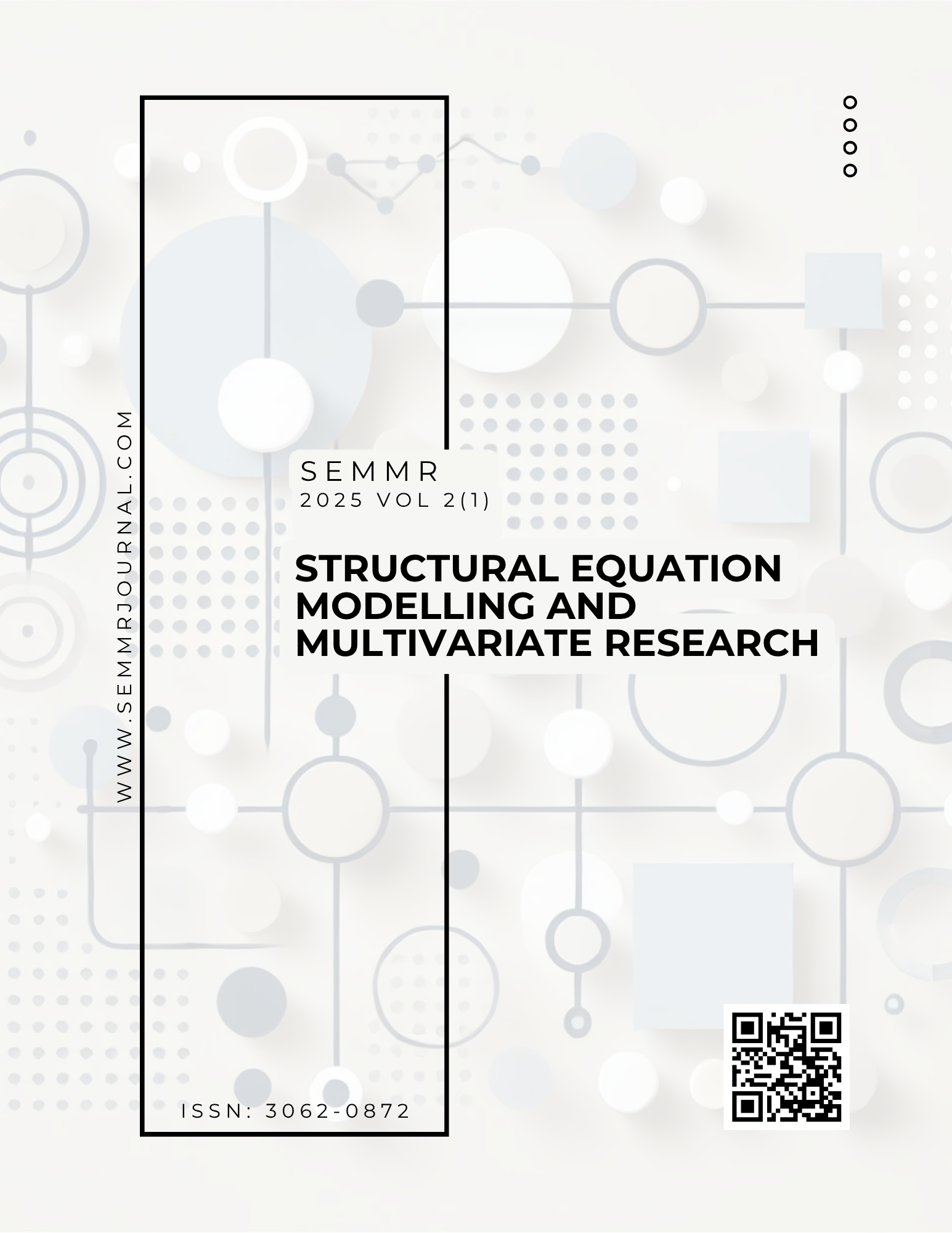The Effects of Social Media Addiction, Social Appearance Anxiety and Body Mass Index on Self-Esteem of University Students with Pls-Sem Approach
DOI:
https://doi.org/10.5281/zenodo.15745570Keywords:
Self-Esteem, Social Media Addiction, Social Appearance Anxiety, Body Mass Index, PLS-SEMAbstract
The aim of this study is to examine the effects of social media addiction, social appearance anxiety and body mass index (BMI) on self-esteem in university students. 415 randomly selected students studying at Düzce University were included in the study. Data were collected using a personal information form, Social Media Addiction Scale, Social Appearance Anxiety Scale, and Rosenberg Self-Esteem Scale. Partial least squares structural equation modeling (PLS-SEM) approach was used in the analysis of the data. As a result of the analysis, it was found that the PLS-SEM model was valid and reliable. It was determined that social appearance anxiety and social media addiction had negative and significant effects on students' self-esteem, but BMI did not have a significant direct effect. Also, BMI had a negative and significant indirect effect on self-esteem through social appearance anxiety. The direct effects of BMI on social appearance anxiety and social appearance anxiety on social media addiction were found to be significant (p<0.05). We thought that the results of this study may be important especially for researchers providing guidance and counseling services to university students.
Downloads
References
Acar, I. H., Avcılar, G., Yazıcı, G., & Bostancı, S. (2022). The roles of adolescents’ emotional problems and social media addiction on their self-esteem. Current Psychology, 41(10), 6838-6847. https://doi.org/10.1007/s12144-020-01174-5
Ahadzadeh, A. S., Rafik-Galea, S., Alavi, M., & Amini, M. (2018). Relationship between body mass index, body image, and fear of negative evaluation: Moderating role of self-esteem. Health Psychology Open, 5(1). https://doi.org/10.1177/2055102918774251
ALAhmari, T., Alomar, A. Z., ALBeeybe, J., Asiri, N., ALAjaji, R., ALMasoud, R., & Al-Hazzaa, H. M. (2019). Associations of self-esteem with body mass index and body image among Saudi college-age females. Eating and Weight Disorders-Studies on Anorexia, Bulimia and Obesity, 24, 1199-1207. https://doi.org/10.1007/s40519-017-0471-0
Akın G., Söyler, H. Ç., & Müezzin, E. (2024). Üniversite öğrencilerinde sosyal medya bağimliliği benlik saygisi ve psikolojik dayaniklilik arasindaki ilişkinin incelenmesi. The Journal of Social Sciences, 71(71), 305-320. http://dx.doi.org/10.29228/SOBIDER.76983
Amil, O., & Bozgeyikli, H. (2015). Investigating the relationship between social appearance anxiety and loneliness of Turkish University youth. Journal of Studies in Social Sciences, 11(1), 68–96.
Andreassen, C. S., Pallesen, S., & Griffiths, M. D. (2017). The relationship between addictive use of social media, narcissism, and self-esteem: Findings from a large national survey. Addictive Behaviors, 64, 287–293. https://doi.org/10.1016/j.addbeh.2016.03.006
Armstrong, L., Phillips, J. G., & Saling, L. L. (2000). Potential determinants of heavier Internet usage. International Journal of Human-Computer Studies, 53, 537–550. doi:10.1006/ijhc.2000.0400
Aydoğan, D. (2024). Sosyal medya bağımlılığı, benlik saygısı ilişkisinde beden memnuniyetinin aracılık rolü analizi. Erciyes İletişim Dergisi, 11(1), 135-153. https://doi.org/10.17680/erciyesiletisim.1343524
Baltacı, U. B., Yılmaz, M., & Traş, Z. (2021). The relationships between internet addiction, social appearance anxiety and coping with stress. International Education Studies, 14(5), 135-144. https://doi.org/10.5539/ies.v14n5p135
Baturay, M. H., & Toker, S. (2017). Self-esteem shapes the impact of GPA and general health on Facebook addiction: A mediation analysis. Social Science Computer Review, 35(5), 555–575. doi:10.1177/0894439316656606
Baykal, S. (2022). Üniversite öğrencilerinin sosyal medya bağımlılığı ile benlik saygısı arasındaki ilişkinin incelenmesi (Master's thesis, İstanbul Gelişim Üniversitesi Lisansüstü Eğitim Enstitüsü).
Behera, N., & Pandey, K. (2025). The Mediational effect of resilience and self-esteem in the relationship between social appearance anxiety and psychological adjustment. Journal of The Indian Academy of Applied Psychology, 1(1), 215. https://doi.org/10.5281/zenodo.14678961
Boursier, V., Gioia, F., Musetti, A., & Schimmenti, A. (2020). Facing loneliness and anxiety during the COVID-19 isolation: the role of excessive social media use in a sample of Italian adults. Frontiers in psychiatry, 11, 586222. https://doi.org/10.3389/fpsyt.2020.586222
Buran Köse, Ö., & Doğan, A. (2018). The relationship between social media addiction and self-esteem among Turkish university students. Addicta: The Turkish Journal on Addictions, 6, 175−190. http://dx.doi.org/10.15805/addicta.2019.6.1.0036
Colak, M., Bingol, O. S., & Dayi, A. (2023). Self-esteem and social media addiction level in adolescents: The mediating role of body image. Indian journal of psychiatry, 65(5), 595-600. https://doi.org/10.4103/indianjpsychiatry.indianjpsychiatry_306_22
Çömlekçi, M. F., & Başol, O. (2019). Gençlerin sosyal medya kullanım amaçları ile sosyal medya bağımlılığı ilişkisinin incelenmesi. Manisa Celal Bayar Üniversitesi Sosyal Bilimler Dergisi, 17(4), 173-188. https://doi.org/10.18026/cbayarsos.525652
Çuhadaroğlu, F. (1986). Adölesanlarda benlik saygısı [Self-esteem in adolescents] (Master’s thesis, Hacettepe University Faculty of Medicine, Ankara, Turkey). Retrieved from https://tez.yok.gov.tr/UlusalTezMerkezi/
Dijital 2024: Küresel Görünüm Raporu. Türkiye İşveren Sendikaları Konfederasyonu. https://www.tisk.org.tr/dokuman/dijital-2024-kuresel-gorunum-raporu.pdf
Doğan, T. (2010). Sosyal Görünüş Kaygısı Ölçeği’nin (SGKÖ) Türkçe Uyarlaması: Geçerlik ve Güvenirlik Çalışması. Hacettepe Üniversitesi Eğitim Fakültesi Dergisi, 39(39), 151-159.
Doğan, U., & Çolak, T. S. (2016). Self-concealment, social network sites usage, social appearance anxiety, loneliness of high school students: a model testing. Journal of Education and Training Studies, 4(6), 176-183. http://dx.doi.org/10.11114/jets.v4i6.1420
Fornell, C., & Lacker, D. F. (1981), “Evaluating structural equation models with unobservable variables and measurement error”, Journal of Marketing Research, Vol.18: 39-50. doi:10.1177/002224378101800104
Göbel, P., Şanlıer, N., Yılmaz, S., & Kocabaş, Ş. (2023). Social appearance anxiety and self-esteem in women: could body mass index have a mediating role?. Behavioral Psychology= Psicología Conductual, 31(1), 25-37. https://doi.org/10.51668/bp.8323102n
Günüç, S. (2009). İnternet Bağımlılık Ölçeği’nin geliştirilmesi ve bazı demografik değişkenler ile in ternet bağımlılığı arasındaki ilişkilerin incelenmesi (Yüksek lisans tezi, Yüzüncü Yıl Üniversitesi, Sosyal Bilimler Enstitüsü, Van)
Hair Jr, J. F., Hult, G. T. M., Ringle, C. M., Sarstedt, M., Danks, N. P., & Ray, S. (2021). Partial least squares structural equation modeling (PLS-SEM) using R: A workbook (p. 197). Springer Nature.
Hart, T.A., Flora, D.B., Palyo, S.A., Fresco, D.M., Holle, C., & Heimberg, R.G. (2008). Development and Examination of the Social Appearance Anxiety Scale. Assessment, 15, 48 - 59. DOI:10.1177/1073191107306673
Hawi, N. S., & Samaha, M. (2017). The relations among social media addiction, self-esteem, and life satisfaction in university students. Social Science Computer Review, 35(5), 576-586. https://doi.org/10.1177/0894439316660340
Hou, Y., Xiong, D., Jiang, T., Song, L., & Wang, Q. (2019). Social media addiction: Its impact, mediation, and intervention. Cyberpsychology: Journal of Psychosocial Research on Cyberspace, 13(1), Article 4. https://doi.org/10.5817/CP2019-1-4
İnik, H., Akçakesea, A., & Demirel, D. H. (2024). Exploring Gender differences, perceptions, and behaviors: the interplay between social media addiction and social appearance anxiety among young adults. Studies in Psychological Science, 2(3), 35-55. doi:10.56397/SPS.2024.09.05
Jeon, J. H. (2005). The effect of the extent of internet use and social supports for adolescent depression and self-esteem (Master’s thesis, The Graduate School of Yonsei University, Seoul).
Kaya, B. (2024). Internet addiction and social appearance anxiety: a meta-analysis. Educational Academic Research, (54), 144-153. DOI: 10.33418/education.1556808
Khan, A. (2024). Impact of social media usage and social appearance anxiety on social relationship and self-esteem among young adults. International Journal of Interdisciplinary Approaches in Psychology, 2(5), 1446-1461.
Lau, G. S. J., Idang, J. (2022). The relationship between selfie-editing, self-esteem, and social appearance anxiety among university students. International Journal of Advanced Research in Future Ready Learning and Education, 26(1), 1-8. DOI: https://doi.org/10.37934/frle.26.1.18
Liao, J., Xia, T., Xu, X., & Pan, L. (2023). The effect of appearance anxiety on social anxiety among college students: sequential mediating effects of self-efficacy and self-esteem. Behavioral Sciences, 13(8):692. https://doi.org/10.3390/bs13080692
Mann, M., Hosman, C.M., Schaalma, H., & de Vries, N.K. (2004). Self-esteem in a broad-spectrum approach for mental health promotion. Health education research, 19 4, 357-72 . https://doi.org/10.1093/her/cyg041
Özer, P., & Güzel, Ş. (2023). Sosyal görünüş kaygısı ve sosyal medya bağımlılığının estetik işlem yaptırma algısı ile ilişkisi. Süleyman Demirel Üniversitesi Vizyoner Dergisi, 14(40), 1412-1432. https://doi.org/10.21076/vizyoner.1258228
Papacharissi, Z., & Rubin, A. M. (2000). Predictors of internet use. Journal of Broadcasting & Electronic Media, 44(2), 175–196. https://doi.org/10.1207/s15506878jobem4402_2
Rosenberg, M. (1965). Society and the adolescent self-image. Princeton, NJ: Princeton University Press.
Sezgin, M. & Uzun, B.N. (2023). Mediating role of social approval need in the relationship between social media addiction and social appearance anxiety, International Journal of Education Technology and Scientific Researches, 8(24), 2546-2558.
Tenenhaus, M., Vinzi, V. E., Chatelin, Y. M., & Lauro, C. (2005). PLS path modeling. Computational statistics & data analysis, 48(1), 159-205. DOI:10.1016/j.csda.2004.03.005
Topuz, R., Bahadir, Z., & Erdogan, Ç. H. (2019). Examining the social appearance anxiety and self-esteem levels of students of the sport management department. Asian Journal of Education and Training, 5(1), 74-79. DOI: 10.20448/journal.522.2019.51.74.79
Vogel, E. A., Rose, J. P., Roberts, L. R., & Eckles, K. (2014). Social comparison, social media, and self-esteem. Psychology of Popular Media Culture, 3, 206–222. https://doi.org/10.1037/ppm0000047
Yilmaz V., Surmelioglu Y. (2024). Measuring automobile service quality with the European customer satisfaction index model (ECSI): the moderating effect of trust. The TQM Journal, 1754-2731. DOI: 10.1108/tqm-10-2023-0315
Downloads
Published
How to Cite
Issue
Section
License
Copyright (c) 2025 Fisun Kaşkır Kesin

This work is licensed under a Creative Commons Attribution 4.0 International License.




